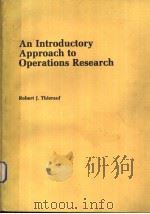《OPERATIONS RESEARCH AN INTRODUCTION》
| 作者 | 编者 |
|---|---|
| 出版 | 未查询到或未知 |
| 参考页数 | 1001 |
| 出版时间 | 没有确切时间的资料 目录预览 |
| ISBN号 | 无 — 求助条款 |
| PDF编号 | 812395948(仅供预览,未存储实际文件) |
| 求助格式 | 扫描PDF(若分多册发行,每次仅能受理1册) |

初级篇1
Chapter 1What Is Operations Research?1
1.1 Operations Research Models1
1.2 Solving the OR Model4
1.3 Queuing and Simulation Models5
1.4 Art of Modeling5
1.5 More Than Just Mathematics7
1.6 Phases of an OR Study8
1.7 About This Book10
References10
Chapter 2Modeling with Linear Programming11
2.1 Two-Variable LP Model12
2.2Graphical LP Solution15
2.2.1 Solution of a Maximization Model16
2.2.2 Solution of a Minimization Model23
2.3Selected LP Applications27
2.3.1 Urban Planning27
2.3.2 Currency Arbitrage32
2.3.3 Investment37
2.3.4 Production Planning and Inventory Control42
2.3.5 Blending and Refining51
2.3.6 Manpower Planning57
2.3.7 Additional Applications60
2.4Computer Solution with Solver and AMPL68
2.4.1 LP Solution with Excel Solver69
2.4.2 LP Solution with AMPL73
References80
Chapter 3The Simplex Method and Sensitivity Analysis81
3.1LP Model in Equation Form82
3.1.1 Converting Inequalities into Equations with Nonnegative Right-Hand Side82
3.1.2 Dealing with Unrestricted Variables84
3.2 Transition from Graphical to Algebraic Solution85
3.3The Simplex Method90
3.3.1 Iterative Nature of the Simplex Method90
3.3.2 Computational Details of the Simplex Algorithm93
3.3.3 Summary of the Simplex Method99
3.4 Artificial Starting Solution103
3.4.1M-Method104
3.4.2 Two-Phase Method108
3.5 Special Cases in the Simplex Method113
3.5.1Degeneracy113
3.5.2 Alternative Optima116
3.5.3 Unbounded Solution119
3.5.4 Infeasible Solution121
3.6 Sensitivity Analysis123
3.6.1Graphical Sensitivity Analysis123
3.6.2 Algebraic Sensitivity Analysis—Changes in the Right-Hand Side129
3.6.3 Algebraic Sensitivity Analysis—Objective Function139
3.6.4 Sensitivity Analysis with TORA, Solver, and AMPL146
References150
Chapter 4Duality and Post-Optimal Analysis151
4.1 Definition of the Dual Problem151
4.2 Primal-Dual Relationships156
4.2.1Review of Simple Matrix Operations156
4.2.2 Simplex Tableau Layout158
4.2.3 Optimal Dual Solution159
4.2.4 Simplex Tableau Computations165
4.3 Economic Interpretation of Duality169
4.3.1Economic Interpretation of Dual Variables170
4.3.2 Economic Interpretation of Dual Constraints172
4.4 Additional Simplex Algorithms174
4.4.1Dual Simplex Algorithm174
4.4.2 Generalized Simplex Algorithm180
4.5 Post-Optimal Analysis181
4.5.1Changes Affecting Feasibility182
4.5.2 Changes Affecting Optimality187
References191
Chapter 5Transportation Model and Ilts Variants193
5.1 Definition of the Transportation Model194
5.2 Nontraditional Transportation Models201
5.3 The Transportation Algorithm206
5.3.1Determination of the Starting Solution207
5.3.2 Iterative Computations of the Transportation Algorithm211
5.3.3 Simplex Method Explanation of the Method of Multipliers220
5.4 The Assignment Model221
5.4.1The Hungarian Method222
5.4.2 Simplex Explanation of the Hungarian Method228
5.5 The Transshipment Model229
References234
Chapter 6Network Models235
6.1 Scope and Definition of Network Models236
6.2 Minimal Spanning Tree Algorithm239
6.3 Shortest-Route Problem243
6.3.1Examples of the Shortest-Route Applications243
6.3.2 Shortest-Route Algorithms248
6.3.3 Linear Programming Formulation of the Shortest-Route Problem257
6.4 Maximal flow model263
6.4.1Enumeration of Cuts263
6.4.2 Maximal Flow Algorithm264
6.4.3 Linear Programming Formulation of Maximal Flow Mode273
6.5 CPM and PERT275
6.5.1Network Representation277
6.5.2 Critical Path (CPM) Computations282
6.5.3 Construction of the Time Schedule285
6.5.4 Linear Programming Formulation of CPM292
6.5.5 PERT Networks293
References296
Chapter 7Goal Programming297
7.1 A Goal Programming Formulation298
7.2Goal Programming Algorithms302
7.2.1 The Weights Method302
7.2.2 The Preemptive Method305
References312
Chapter 8Integer Linear Programming313
8.1Illustrative Applications314
8.1.1 Capital Budgeting314
8.1.2 Set-Covering Problem318
8.1.3 Fixed-Charge Problem324
8.1.4 Either-Or and If-Then Constraints328
8.2Integer Programming Algorithms333
8.2.1 Branch-and-Bound (BB) Algorithm334
8.2.2 Cutting-Plane Algorithm343
8.2.3 Computational Considerations in ILP348
8.3Traveling Salesperson (TSP) Problem349
8.3.1 Heuristic Algorithms353
8.3.2 BB Solution Algorithm356
8.3.3 Cutting-Plane Algorithm359
References361
Chapter 9Deterministic Dynamic Programming363
9.1 Recursive Nature of Computations in DP364
9.2 Forward and Backward Recursion367
9.3Selected DP Applications369
9.3.1 Knapsack/Fly-Away/Cargo-Loading Model369
9.3.2 Work-Force Size Model377
9.3.3 Equipment Replacement Model380
9.3.4 Investment Model384
9.3.5 Inventory Models387
9.4 Problem of Dimensionality388
References390
Chapter 10Determiniistic Inventory Models391
10.1 General Inventory Model391
10.2 Role of Demand in the Development of Inventory Models392
10.3 Static Economic-Order-Quantity (EOQ) Models394
10.3.1 Classic EOQ model394
10.3.2 EOQ with Price Breaks400
10.3.3 Multi-Item EOQ with Storage Limitation404
10.4 Dynamic EOQ Models407
10.4.1 No-Setup Model409
10.4.2 Setup Model413
References425
Chapter 11Decision Analysis and Games427
11.1 Decision Making under Certainty—Analytic Hierarchy Process (AHP)428
11.2 Decision Making under Risk438
11.2.1 Decision Tree-Based Expected Value Criterion438
11.2.2 Variations of the Expected Value Criterion444
11.3 Decision under Uncertainty453
11.4 Game Theory458
11.4.1 Optimal Solution of Two-Person Zero-Sum Games459
11.4.2 Solution of Mixed Strategy Games462
References468
Chapter 12Queuing Systems469
12.1 Why Study Queues?470
12.2 Elements of a Queuing Model471
12.3 Role of Exponential Distribution473
12.4 Pure Birth and Death Models (Relationship Between the Exponential and Poisson Distributions)476
12.4.1 Pure Birth Model476
12.4.2 Pure Death Model480
12.5 Generalized Poisson Queuing Model483
12.6 Specialized Poisson Queues488
12.6.1 Steady-State Measures of Performance489
12.6.2 Single-Server Models493
12.6.3 Multiple-Server Models502
12.6.4 Machine Servicing Model—(M/M/R): (GD/K/K),R<K512
12.7 (M/G/1) : (GD/∞/∞)—Pollaczek-Khintchine (P-K) Formula515
12.8 Other Queuing Models517
12.9 Queuing Decision Models517
12.9.1 Cost Models518
12.9.2 Aspiration Level Model522
References524
Appendix A AMPL Modeling Language525
A.1Rudimentary AMPL Model525
A.2 Components of AMPL Model526
A.3 Mathematical Expressions and Computed Parameters534
A.4 Subsets and Indexed Sets537
A.5 Accessing External Files539
A.5.1 Simple Read Files539
A.5.2 Using Print or Printf to Retrieve Output541
A.5.3 Input Table Files541
A.5.4 Output Table Files544
A.5.5 Spreadsheet Input/Output Tables546
A.6 Interactive Commands546
A.7 Iterative and Conditional Execution of AMPL Commands548
A.8 Sensitivity Analysis Using AMPL550
Reference550
高级篇551
Chapter 13Advanced Linear Programming551
13.1 Simplex Method Fundamentals552
13.1.1 From Extreme Points to Basic Solutions554
13.1.2 Generalized Simplex Tableau in Matrix Form557
13.2 Revised Simplex Method560
13.2.1 Development of the Optimality and Feasibility Conditions561
13.2.2 Revised Simplex Algorithm563
13.3 Bounded-Variables Algorithm569
13.4 Duality575
13.4.1 Matrix Definition of the Dual Problem576
13.4.2 Optimal Dual Solution576
13.5 Parametric Linear Programming580
13.5.1 Parametric Changes in C581
13.5.2 Parametric Changes in b584
References586
Chapter 14Review of BasicProbability587
14.1 Laws of Probability587
14.1.1 Addition Law of Probability588
14.1.2 Conditional Law of Probability589
14.2 Random Variables and Probability Distributions591
14.3 Expectation of a Random Variable593
14.3.1 Mean and Variance (Standard Deviation) of a Random Variable594
14.3.2 Mean and Variance of Joint Random Variables596
14.4 Four Common Probability Distributions599
14.4.1 Binomial Distribution599
14.4.2 Poisson Distribution600
14.4.3 Negative Exponential Distribution601
14.4.4 Normal Distribution602
14.5 Empirical Distributions605
References612
Chapter 15Probabilistic InventoryModels613
15.1 Continuous Review Models614
15.1.1 “Probabilitized” EOQ Model614
15.1.2 Probabilistic EOQ Model616
15.2 Single-Period Models621
15.2.1 No-Setup Model (Newsvendor Model)621
15.2.2 Setup Model (s-S Policy)625
15.3 Multiperiod Model627
References630
Chapter 16Simulation Modeling631
16.1 Monte Carlo Simulation631
16.2 Types of Simulation636
16.3 Elements of Discrete-Event Simulation637
16.3.1 Generic Definition of Events637
16.3.2 Sampling from Probability Distributions639
16.4 Generation of Random Numbers648
16.5 Mechanics of Discrete Simulation650
16.5.1 Manual Simulation of a Single-Server Model650
16.5.2 Spreadsheet-Based Simulation of the Single-Server Model656
16.6 Methods for Gathering Statistical Observations659
16.6.1 Subinterval Method660
16.6.2 Replication Method661
16.6.3 Regenerative (Cycle) Method662
16.7 Simulation Languages664
References666
Chapter 17Markov Chains667
17.1 Definition of a Markov Chain667
17.2 Absolute and n-Step Transition Probabilities670
17.3 Classification of the States in a Markov Chain672
17.4 Steady-State Probabilities and Mean Return Times of Ergodic Chains675
17.5 First Passage Time680
17.6 Analysis of Absorbing States684
References689
Chapter 18Classical Optimization Theory691
18.1 Unconstrained Problems691
18.1.1 Necessary and Sufficient Conditions692
18.1.2 The Newton-Raphson Method696
18.2 Constrained Problems698
18.2.1 Equality Constraints699
18.2.2 Inequality Constraints—Karush-Kuhn-Tucker (KKT) Conditions711
References716
Chapter 19Nonlinear Programming Algorithms717
19.1 Unconstrained Algorithms717
19.1.1 Direct Search Method717
19.1.2 Gradient Method721
19.2 Constrained Algorithms725
19.2.1 Separable Programming725
19.2.2 Quadratic Programming734
19.2.3 Chance-Constrained Programming739
19.2.4 Linear Combinations Method744
19.2.5 SUMT Algorithm747
References748
Chapter 20Additional Network and LP Algorithms749
20.1 Minimum-Cost Capacitated Flow Problem749
20.1.1 Network Representation750
20.1.2 Linear Programming Formulation752
20.1.3 Capacitated Network Simplex Algorithm757
20.2 Decomposition Algorithm764
20.3 Karmarkar Interior-Point Method773
20.3.1 Basic Idea of the Interior-Point Algorithm773
20.3.2 Interior-Point Algorithm775
References784
Chapter 21Forecasting Models785
21.1 Moving Average Technique785
21.2 Exponential Smoothing789
21.3 Regression790
References794
Chapter 22Probabilistic Dynamic Programming795
22.1 A Game of Chance795
22.2 Investment Problem798
22.3 Maximization of the Event of Achieving a Goal802
References805
Chapter 23Markovian Decision Process807
23.1 Scope of the Markovian Decision Problem807
23.2 Finite-Stage Dynamic Programming Model809
23.3 Infinite-Stage Model813
23.3.1 Exhaustive Enumeration Method813
23.3.2 Policy Iteration Method Without Discounting816
23.3.3 Policy Iteration Method with Discounting819
23.4 Linear Programming Solution822
References826
Chapter 24Case Analysis827
Case 1: Airline Fuel Allocation Using Optimum Tankering828
Case 2: Optimization of Heart Valves Production835
Case 3: Scheduling Appointments at Australian Tourist Commission Trade Events838
Case 4: Saving Federal Travel Dollars842
Case 5: Optimal Ship Routing and Personnel Assignment for Naval Recruitment in Thailand846
Case 6: Allocation of Operating Room Time in Mount Sinai Hospital852
Case 7: Optimizing Trailer Payloads at PFG Building Glass856
Case 8: Optimization of Crosscutting and Log Allocation at Weyerhaeuser862
Case 9: Layout Planning for a Computer Integrated Manufacturing (CIM) Facility867
Case 10: Booking Limits in Hotel Reservations874
Case 11: Casey's Problem: Interpreting and Evaluating a New Test877
Case 12: Ordering Golfers on the Final Day of Ryder Cup Matches880
Case 13: Inventory Decisions in Dell's Supply Chain882
Case 14: Analysis of an Internal Transport System in a Manufacturing Plant885
Case 15: Telephone Sales Manpower Planning at Qantas Airways888
Appendix B Statistical Tables895
Appendix C Partial Solutions to Answers Problems899
Appendix D Review of Vectors and Matrices949
D.1 Vectors949
D.1.1 Definition of a Vector949
D.1.2 Addition (Subtraction) of Vectors949
D.1.3 Multiplication of Vectors by Scalars950
D.1.4 Linearly Independent Vectors950
D.2 Matrices950
D.2.1 Definition of a Matrix950
D.2.2 Types of Matrices950
D.2.3 Matrix Arithmetic Operations951
D.2.4 Determinant of a Square Matrix952
D.2.5 Nonsingular Matrix954
D.2.6 Inverse of a Nonsingular Matrix954
D.2.7 Methods of Computing the Inverse of Matrix955
D.2.8 Matrix Manipulations Using Excel960
D.3 Quadratic Forms961
D.4Convex and Concave Functions963
Problems963
Selected References964
Appendix E Case Studies965
《OPERATIONS RESEARCH AN INTRODUCTION》由于是年代较久的资料都绝版了,几乎不可能购买到实物。如果大家为了学习确实需要,可向博主求助其电子版PDF文件。对合法合规的求助,我会当即受理并将下载地址发送给你。
高度相关资料
-

- INTRODUCTION TO OPERATIONS RESEARCH
- 1980 COPYRIGHT
-

- Operations Research An Annotated Bibliography Volume 2
- 1962 Saint Louis University Press
-

- Operations Research An Introduction Fourth Edition
- 1987 Macmilian publishing company
-

- Operations research: an introduction Second Edition
- 1976 Macmillan
-

- Introduction to operations research
- 1967 Holden-Day
-

- Introduction to operations research Sixth Edition
- 1999 China Machine Press
-

- Operations research: an introduction to linear optimization and decision analysis
- 1979 North Holland
-

- AN INTRODUCTION TO SOCIAL RESEARCH
- 1929 HENRY HOLT AND COMPANY
-

- MASS MEDIA RESEARCH AN INTRODUCTION
- 1997 WADSWORTH PUBLISHING COMPANY
-

- Introduction to operations research Third Edition
- 1980 Holden-Day
提示:百度云已更名为百度网盘(百度盘),天翼云盘、微盘下载地址……暂未提供。➥ PDF文字可复制化或转WORD




